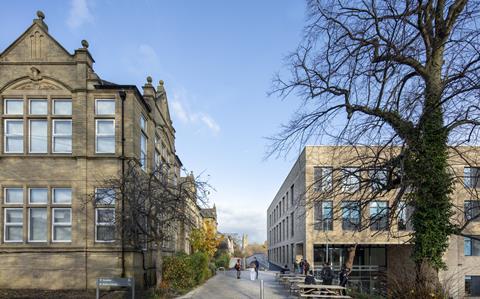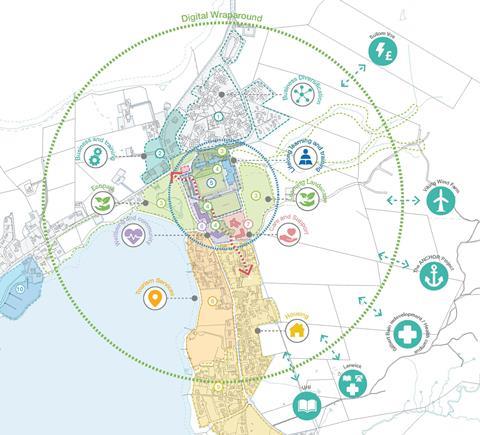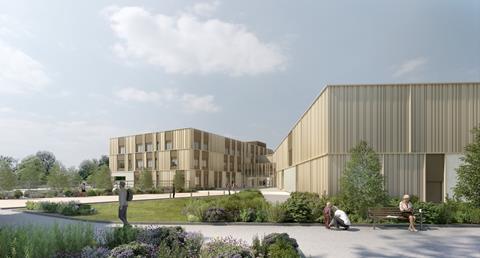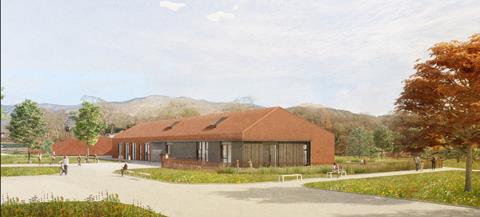Scotland’s Learning Estate Investment Programme (LEIP) and England’s School Rebuilding Programme (SRP) take markedly different paths in how they fund, brief and deliver new schools. While the DfE model prizes standardisation and efficiency, LEIP embraces flexibility and place-based design. As pressures mount to deliver better outcomes with fewer resources, what can each approach learn from the other—and how can the construction industry play a smarter role in shaping the next generation of schools? Chris Malcolm, principal, Ryder Architecture explores.

One of the hallmarks of the education sector in the Scottish construction industry is the willingness to collaborate and freely share experiences between designers, contractors, local authorities, practitioners and Scottish Government.
This exchange of knowledge is no doubt helped by the smaller scale of the sector relative to the rest of the UK, as well as a genuine desire to deliver the best outcomes for our places.
A workshop facilitated by Scottish Futures Trust (SFT) set the challenge for us all to consider how we can deliver a more efficient Scottish learning estate. During the workshop, discussion ranged to how things are done in other locations, with the approach of England’s Department for Education (DfE) being a natural comparator.
The cost difference between schools in the Scottish Learning Estate Investment Programme (LEIP) and those in the DfE School Rebuilding Programme (SRP) appears significant when looked at in isolation, with those in England being lower than Scotland on a cost per square metre basis. Schools in Scotland also provide a greater area per pupil than those south of the border.
A good starting point is understanding the strategic, educational and place objectives of each programme when looking to make any comparisons between them.
The SRP in England prioritises improving the condition of the school estate to standards set by the DfE as a single client body, with priority given to those with the highest condition need and those with the potential to cause significant harm to pupils and staff.
There is also a constant requirement to drive down the cost of capital projects. New schools in England are provided with a set gross internal floor area within which to deliver spaces for a largely subject-based curriculum.
LEIP has wider-reaching objectives – to deliver a more sustainable, maintainable and digitally-enabled education estate. It must meet the educational needs of 32 individual Scottish local authorities, who have a varying range of priorities influenced by the geography and demographics of their context.
It’s a programme which looks beyond the redline boundary of a site to encourage more joined up thinking about how the public sector delivers services to meet place needs and stimulate economic growth.
In Scotland, pupil metrics are used to generate an area which determines the level of project funding. How area is allocated within the building is decided by the local authorities through briefing and design development to meet educational needs.
This can result in school designs which are above or below SFT metric areas, providing a high degree of flexibility, although the level of funding will remain fixed.

What can we learn from each programme?
It’s clear that the differences between the two programmes run far deeper than the cost per square metre of a new project.
Each programme is attempting to address specific educational and societal priorities, which manifest themselves in the physical form of their respective learning estates, expressing the value placed on learning in our communities. Despite these differences, there are still important lessons that each programme could learn from the other.
One size doesn’t fit all… but there is common ground
The benefits of the DfE approach to briefing, baseline designs and standard space types and sizes are high levels of consistency, reduced risk and streamlined development periods.
However, this centralised approach does have challenges. One size inevitably does not fit all, and that can result in a gap between the actual needs of individual schools and places and what is defined centrally.
The LEIP approach offers flexibility in how briefs are met but, when applied across 32 local authorities, leads to situations where there are inefficiencies – typical classrooms can vary between 54.5 sq m and 60 sq m for the same pupil roll, with impacts on replicability of structural, services and furniture and fitting solutions.
There are clear benefits to having greater consistency of these key building blocks across Scotland.

Standardisation polarises the construction industry – contractors are enthused by the consistency it promises to deliver, while designers fear the lack of flexibility and the spatial paralysis a limited set of components threaten.
The truth lies somewhere in between. Much of our thinking of standardisation remains based on early twentieth century production-line models of rigorous repetition. However, we are now in an era of digitally enabled mass customisation, allowing us to adopt a more nuanced and flexible approach.
There is nothing wrong with the idea of a kit of parts, it just needs to be a good one.
Think about the simple Lego sets that were available 40 years ago compared to the huge sets of complex but standardised pieces that are available now - a more sophisticated product, but still a kit.
In the same way, the component parts that make up our schools can be derived from the lessons learnt over the last 15 years, creating a range of scalable, flexible components beyond simple class bases and corridors.
We don’t need to reinvent the wheel every time
The absence of large-scale programmes with standardised components and common build strategies in Scotland means that we spend significant amounts of time developing technical solutions on individual projects, for aspects which remain largely invisible to those who use them.
These tend to be minor variations on a common theme, such as external wall and roof performance buildups, floor to floor heights, structural bay depths and fenestration arrangements – but they still impact on both cost and efficiency.
Given there is a convergence in detailing strategy as a result of fabric first principles, there are benefits to be gained from adopting a common approach to the design and specification of these ‘under the hood’ components, drawing lessons from the approach to delivery of the DfE programme, adapting it to meet the performance requirements of LEIP.
This strategy is currently being tested in the Hub North Schools Programme, where the diverse geography and pupil rolls will present a robust proving ground.

The need to take a broader view – being connected
Standardisation and common specifications will drive efficiency in projects, but if we want to achieve real value in our learning estate, we need to embrace a much broader view of how it relates to wider public services.
A new school represents a significant investment in a community, in many cases a once-in-a-generation opportunity.
If we limit our ambition to simply replacing what we already have, and do not look on a new project as a catalyst to address other challenges facing our communities, then our ability to deliver a better connected, more efficient public sector estate is reduced. Much good work is lost for the want of a little more.
Applying a collaborative culture to public services is investing for the future, providing support and intervention at the right stage. It allows a preventative, bottom-up approach rather than a centralised one.
Learners and communities can get access to support in learning, health, employment and social care when it can have the most impact, reducing the need and cost for future intervention.
This requires an approach to briefing where every project is rooted in the wider context of place, considering how community assets and services can be transformed through investment to deliver what is right for the local community.
It should provide a platform for partners to collaborate, improve services or streamline their estate, opening up the possibility for more joined-up local service delivery and more sustainable, efficient estates.
This is an integral part of the LEIP approach and the Scottish Government’s place principle, but it still faces resistance due to cultural inertia with public sector partners, while looking beyond the red line is not currently a driver of the SRP.
The need to have better connected services across the public sector matters from a financial perspective – being able to deliver more with less. More importantly, the right support at the right time strengthens the attributes that we seek to foster in our learners, and this is where true value sits.
“Being connected matters – connected with a wider community, of friends and supporters, enhances your ability to make decisions, enhances your ability to be in control of your life, enhances your self-esteem and gives you a sense of purpose – all the things that are fundamental to a sense of wellbeing.”
Sir Harry Burns, Chief Medical Officer for Scotland 2005-2014
Read the full






















